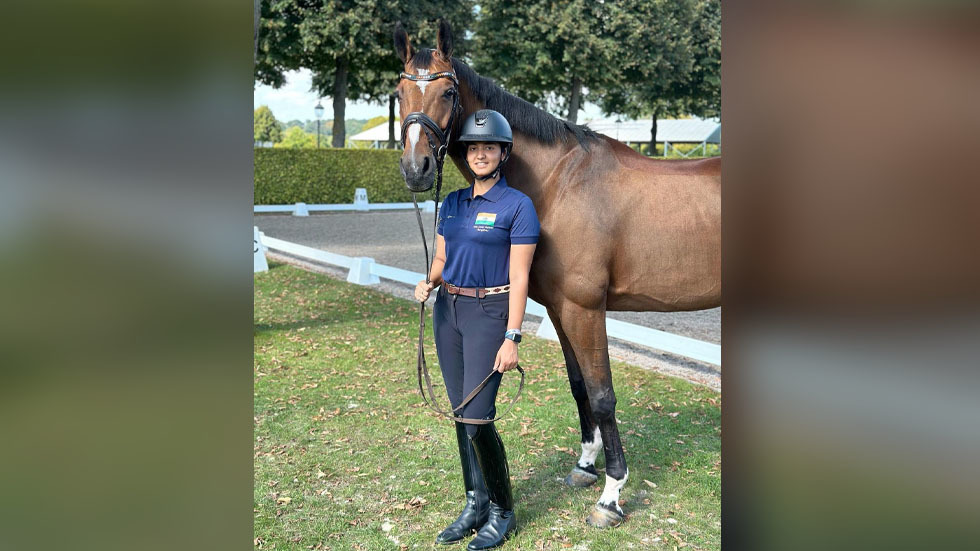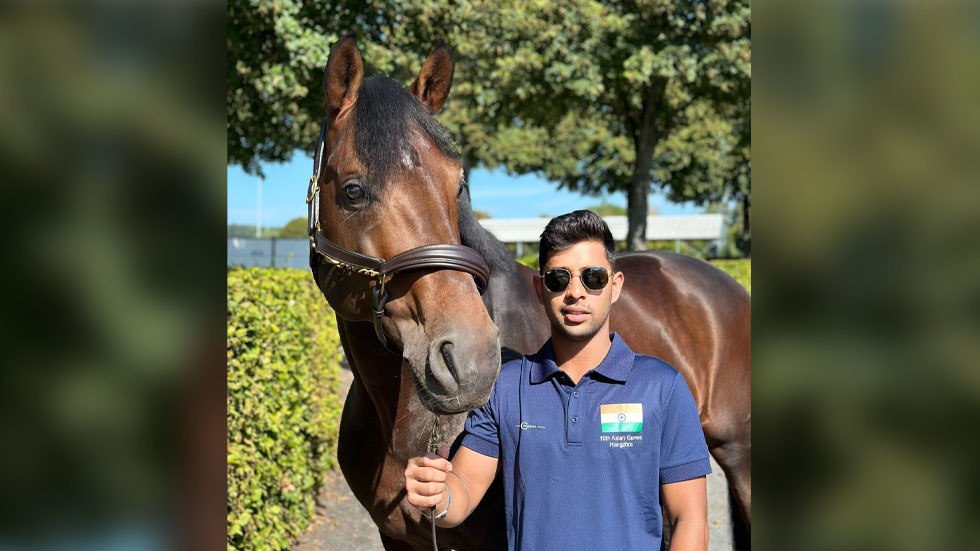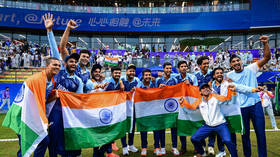Adrenaline, Etro, Chinski, and Emerald: Horses who galloped to the 2023 Asiad and cantered back with India’s first gold in decades
When Adrenaline, Etro, Chinski, and Emerald move, they delight. As they walk or trot, canter or gallop, their hooves provide a rhythm to the music in the backdrop.
These powerful creatures are naughty and playful, and they understand and love all the attention that comes their way.
For equestrians Divyakriti Singh, Sudipti Hajela, Anush Agarwalla, and Hriday Chedda, their horses are their BFFs (best friends forever). After all, they galloped the quartet to gold and glory at the recent 2023 Asian Games in Hangzhou, outperforming favorites such as China and Japan, and marking the first time in 41 years that India achieved the feat.
The previous occasion was in 1982, when Delhi hosted the Asian Games; India won three golds, a silver, and a bronze. India had made its first attempt at the highest level just two years earlier, at the Moscow Olympic Games, which was boycotted by America and several European nations. That team was led by Lt J S Ahluwalia, riding Shiwalik, and epitomizing the fact that equestrian sports were dominated by the army.
The riders in Hangzhou were civilians, showing a growing general participation in the sport. This has been enabled by the Equestrian Federation of India (EFI), set up in 1967 and affiliated to the Switzerland-based Federation Equestre Internationale (FEI). The army provided crutches to the EFI in its infancy, and the military still runs much of India’s equestrian infrastructure.
Such institutional support has been necessary because the sport is costly. If the EFI now has over 1,000 members, that is a reflection of growing wealth in the country and the ability of civilians to train abroad (as we shall see from the individual stories below). The army’s continued presence is not a surprise, as India’s 61st Cavalry is believed to be the world’s largest remaining non-ceremonial horse-mounted cavalry.
However, all the four horses that won in Hangzhou are based in Europe and train there, as they are warmbloods required for dressage. In addition, the coaching in Europe is top-notch, while there are practically no trainers in India. There are competitions every weekend in Europe, which is essential for improvement. Hence Indian riders have no choice but to go to the continent – not just for training but for the horses.
There are also the twin issues of quarantine laws and inadequate budgets that have tied down Indian equestrianism for years.
Horses cost anywhere between €100,000 and €300,000 ($105,000-$315,000). Riders have to pay an additional 42% import duty and keep the horses quarantined for a month, ballooning the costs. The quarantine facilities in India are not the best and the animals suffer poor health as a result, requiring costly veterinarian care. Horses are now being bred in India, but only six to eight a year. They are no match for horses born and bred abroad.
Now, the horses that won gold for India:
Adrenaline
“Adrenaline is my best friend who made my dreams come true. Together, we were able to deliver a personal best score that helped Team India clinch the gold medal,” says 23-year-old Divyakriti Singh, an alumna of Mayo College girls’ school in Ajmer, in India’s desert state of Rajasthan.

Divyakriti was based first in Denmark and then in Germany for her training. She initially trained with a different horse but they could not reach a comfort level. At that stable, Adrenaline was already the superstar. An international dressage rider from Denmark who bred the horse, Helene Melsen, asked Divyakriti to try Adrenaline for the Asiad.
“Prior to my trial I used to take care of Adrenaline occasionally, feeding him and taking him out to the field,” she said. “But once I rode him, the connect was instant and that was the beginning of our partnership. I would take care of him all seven days of the week.”
Adrenaline weighs around 700kg (1,540lbs) and has a mind of his own, says the equestrienne. “We have a bond based on trust, built on the time I spent at the stables.”
At birth, the horse was named Firfod. “Later, he was named Adrenaline,” Divyakriti says. “I liked the name and continued with it. He is a Grand Prix horse and won often for his Danish rider.”
Divyakriti grooms and takes good care of him, which strengthens the bond. “Once horses know they have all your love, they will fight for you to the end. It’s a mature relationship where I speak to Adrenaline in silence,” says Divyakriti, who scored 68.176 in the Asiad.
“Adrenaline, like all other horses, senses everything, even my heartbeat,” she says. “So the key is to be confident and give your horse the confidence.” Divyakriti often gives Adrenaline a little scratch on his neck to relax him. “He also gets a treat after rides, no matter the result.” These include apples, bananas, and carrots.
Etro
Etro is a nine-year-old stallion that Anush has been riding since February. He swears by his horse. “Etro has a strong character. He likes being the center of attention,” says Anush. “Though our partnership is quite young, we were in perfect sync with each other.”

Not only was he part of the gold medal team, Anush and Etro went on to win India’s first-ever bronze in individual dressage at the Hangzhou Asiad. Since 1951, India has won 13 Asiad medals in the equestrian (including the latest gold), but never an individual medal.
Anush credits Etro, a German horse, for both wins.
“With Etro, I felt I was flying in the arena,” smiles the 23-year-old. He scored 73.030 to finish third and claim his second Asiad medal.
“Etro doesn’t run around and is not spooked,” Anush says. “He has good movement and character. All these qualities are a must for dressage.”
Talking of his horse’s pedigree, Anush says Etro’s father too had competed up to the Grand Prix level and a few international shows. “I ensure Etro is obedient and precise in his moves,” Anush says. “Our camaraderie is there throughout.”
Chinski
Sudipti Hajela has had Chinsky for the past two years. “I bought him for the sole purpose of competing in the Asian Games,” she says. “He is one of the best horses I ever had.”
The 16-year-old stallion bonds strongly with Sudipti. “I spend most of my time with Chinski, taking good care,” she says. “He is full of energy all the time and a complete showman who not only helped me win, but also taught me nuances of dressage.”
Chinski possesses a natural balance, athleticism and the perfect bascule (the natural arc a horse’s body takes over a jump) for show jumping. It helped Sudipti score a total of 66.706 at the Asiad.
Like other horses, Chinski loves carrots, bananas, and apples. “We are in perfect sync when riding and he understands me well,” Sudipti says.
Born in Indore in 2002, Sudipti began her equestrian journey at the age of six. It started as a summer hobby but evolved into a passion. Sudipti is banking on Chinski for the Paris 2024 Olympics and both have begun preparation.
Emerald
Hriday Chedda’s horse Emerald is a 14-year-old Dutch warmblood registered with the Royal Warmblood Studbook of the Netherlands. He is owned by Ilse van Cranenbroek, an accomplished equestrienne who operates stables in the Netherlands.
“Emerald was leased out to me for a period of one year,” Hriday says (without disclosing the lease amount).
The small-tour horse made his international debut in February 2017 at the CDI (Concours de Dressage International) Lier in Belgium. In that same year, Emerald competed at the CDIs in Hertogenbosch, Roosendaal and in Mechelen, Belgium. He made his presence felt at the national level in the Netherlands and in the Grand Prix.
For Hriday, the Asiad was a goal for a decade. “I have worked towards it over the years by putting in a lot of effort and training, and gaining experience in Europe. Emerald helped me know him better,” says Hriday, who studied business and management at the University of London.
“Emerald will go back to his owner after returning from Hangzhou,” he says.
As part of his training, Hriday began working alongside trainers and their stables, assisting in day-to-day routines. “I did all chores including mucking out (cleaning the stables) and daily yard duties,” says Hriday. “Emerald and I grew close because of this. It made me the rider that I am today.”
Hriday’s passion for horses started at a young age. “I used to ride ponies that would come by our street in Mumbai,” he recalls. “My first serious interaction with horses was when I went to the horse-riding camp at Japalouppe Equestrian Center (off the Mumbai-Pune expressway), at six. I was bitten by the bug and there has been no looking back.”













